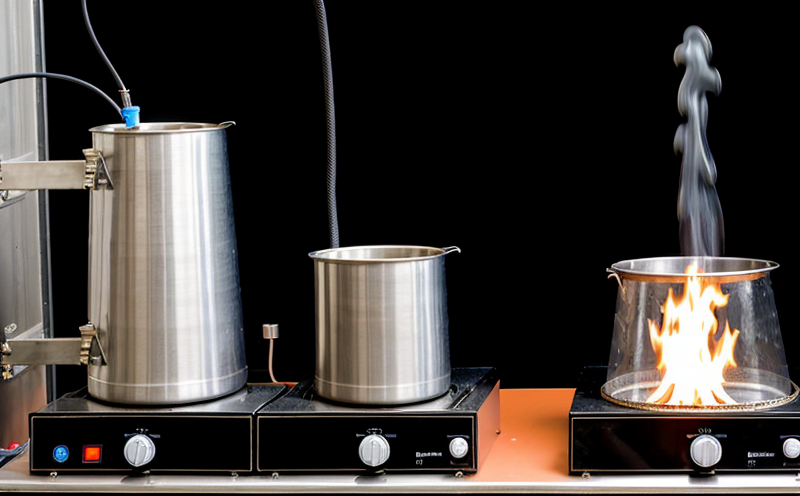Heat Release Testing of Laminates and Composites
The fire safety performance of laminates and composites is critical in various sectors including aerospace, automotive, construction, and electronics. Heat release testing plays a pivotal role in evaluating the flammability characteristics of these materials under controlled laboratory conditions. This test assesses how much heat is released during combustion, providing insights into the material's flame propagation behavior.
Understanding the heat release rate (HRR) helps engineers design safer products and structures by selecting materials that can withstand fire without compromising safety or performance. In this service, we use advanced calorimetric equipment to measure the HRR of laminates and composites according to international standards such as ISO 5660-2:2017 and ASTM E1354.
The testing process involves careful preparation of specimens, typically cut into standard sizes that fit within the calorimeter. The specimen is placed in a controlled atmosphere where it is exposed to an ignition source, and the heat release rate is measured over time. This data provides critical information on the material's thermal stability and potential fire risk.
Our experienced team ensures accurate and reliable results by following stringent protocols outlined in relevant standards. The test not only aids compliance with regulatory requirements but also supports research and development efforts to enhance product safety. By identifying materials' vulnerabilities early, engineers can optimize designs to meet the highest safety standards.
In summary, heat release testing is essential for ensuring that laminates and composites perform reliably under fire conditions. It helps manufacturers and designers make informed decisions regarding material selection and process optimization, thereby enhancing overall product safety and reducing potential risks associated with fire incidents.
Scope and Methodology
| Test Parameters | Measurement Units | Description |
|---|---|---|
| Heat Release Rate (HRR) | kJ/kg/min | The rate at which a material releases heat during combustion. |
| Sustained Ignition Time | s | The duration the specimen remains ignited after ignition. |
| Ventilation Air Flow Rate | L/s | The rate of air flow through the calorimeter to control combustion conditions. |
| Specimen Mass | g | The mass of the material sample used for testing. |
| Calorimeter Temperature | °C | The temperature at which calorimetric measurements are taken. |
The test is conducted using a calorimeter, an instrument that measures the heat released by materials during combustion. The specimen is placed in the calorimeter and exposed to an ignition source. The calorimeter records the heat release rate, sustained ignition time, and other relevant parameters.
For accurate results, specimens are prepared according to specific dimensions detailed in ISO 5660-2:2017 and ASTM E1354. This ensures consistency across tests, allowing for valid comparisons between different materials or versions of the same material.
Why Choose This Test
- Comprehensive evaluation of heat release behavior under controlled conditions.
- Meets regulatory and industry standards (ISO 5660-2:2017, ASTM E1354).
- Supports product safety and compliance with fire regulations.
- Provides valuable data for research and development initiatives.
- Demonstrates the material's suitability for high-risk environments.
- Aids in optimizing manufacturing processes to enhance quality.
- Offers a reliable method for comparing different materials or versions.
The heat release test is essential for ensuring that laminates and composites meet stringent safety requirements. By choosing this service, you gain access to cutting-edge technology and experienced professionals who can help you make informed decisions about material selection and process optimization.
Environmental and Sustainability Contributions
The results of heat release testing play a crucial role in promoting environmental sustainability by informing the development of safer and more sustainable materials. By identifying flammable materials early, manufacturers can replace them with less hazardous alternatives or incorporate fire-retardant additives.
This not only enhances product safety but also contributes to reducing the overall carbon footprint associated with manufacturing and using these products. For instance, in aerospace applications, selecting non-flammable composites reduces the need for heavy fire suppression systems, leading to lighter aircraft that are more fuel-efficient.
Moreover, heat release testing supports sustainable design practices by encouraging the use of materials that can be recycled or repurposed at the end of their lifecycle. This minimizes waste and promotes a circular economy. By adopting such practices, industries can contribute significantly to global sustainability goals while maintaining high standards of product safety.
In conclusion, heat release testing is not only vital for ensuring fire safety but also plays a key role in fostering sustainable development within the materials industry.





